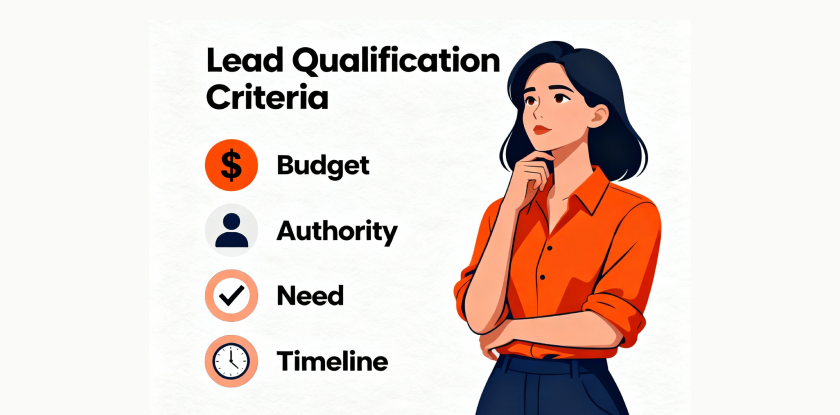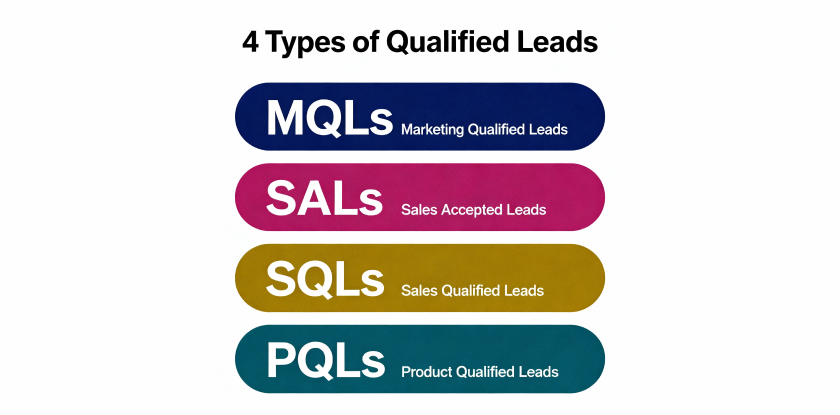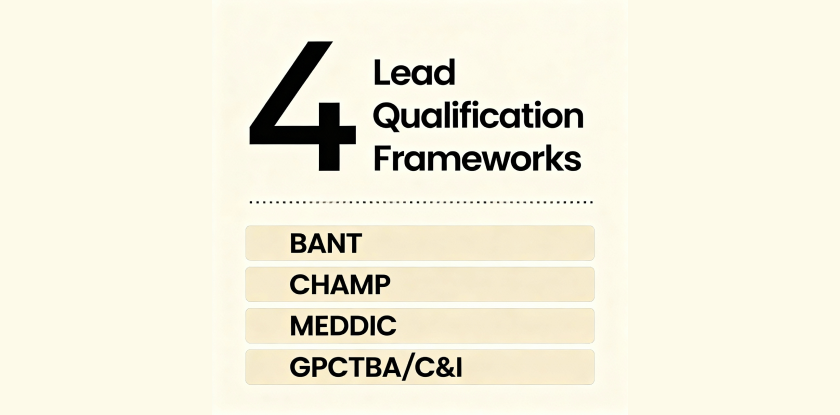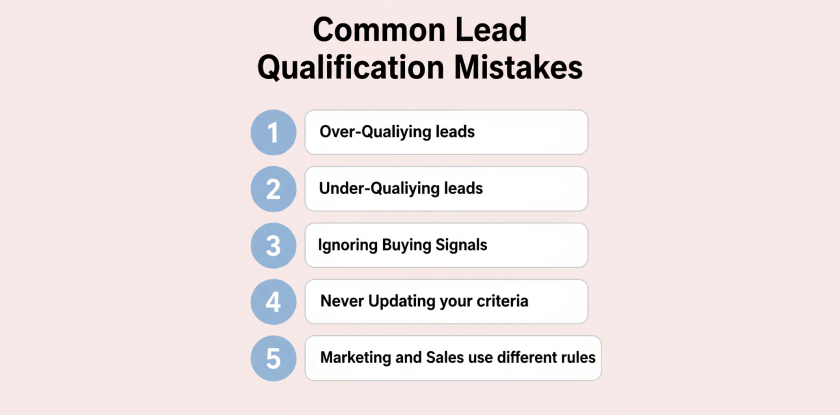Most businesses make the same lead generation mistake.
They skip proper lead qualification criteria and chase every lead without checking if it’s worth the time.
Lead Qualification Criteria means traits that help you spot leads’ budget, need, and intent to buy, so your team doesn’t waste time.
In fact, as per stats, companies that use clear qualification criteria see a 27% higher close rate.
Let’s see those proper qualification criteria to close more deals in 2025.
What is the Lead Qualification Criteria?

Lead qualification criteria are the rules you use to decide if a lead is a good match for your product and likely to buy.
They help sales and marketing focus on the best leads, saving time and effort.
Good lead answers 3 important questions:
- Does this person really need what we’re selling?
- Can they afford to buy it?
- Are they ready to buy soon?
What are the 4 types of Qualified leads?

Before we dive into specific criteria, let’s first clarify which stage your leads are in the sales journey.
Marketing Qualified Leads (MQLs):
MQLs are leads who show interest through marketing activities but aren’t ready to talk to sales yet. They need more nurturing before sales get involved. Below are the ways they show interest:
- Downloaded guides and ebooks
- Attended webinars
- Clicked and read marketing emails
- Checked your pricing page
Sales Accepted Leads (SALs):
This is the forwarding stage.
Here, sales teams review the MQLs sent by the marketing team and decide if they are worth pursuing. If yes, sales accepts them and starts engaging.
This step avoids wasting sales efforts on weak leads.
Sales Qualified Leads (SQLs):
SQLs are leads that have clear interest, budget, and are ready to buy. The sales team gives them the highest priority and most personalized attention. Because these leads have:
- A budget to spend
- A specific problem your product/service can solve
- The decision-maker involved in the process
- A plan to buy within 6 months
Product Qualified Leads (PQLs):
PQLs are leads that have used your product through a free trial or freemium plans and found it valuable. They are more likely to convert at higher rates than traditional MQLs, as they have already experienced what you offer.
Examples:
- Logged in or used the products many times.
- Invited colleagues to join
- They’ve completed important actions in the product
- Hit usage limit
4 Steps of Lead Qualification Criteria to spot High-quality Leads
Lead qualification done right can be a game-changer. It saves your time from getting wasted on bad leads.
But it is only possible when you have good lead qualification criteria. Here are 4 simple ways to make your qualification criteria even better.
Step 1: Initial Research and Discovery
Before you make a call to lead, spend a few minutes learning about the prospects. It’s like reviewing someone’s profile before a meeting, so you can easily understand and pitch them.
What to Research:
- Their website: See what they do & their services.
- LinkedIn profiles of key stakeholders
- Industry news: Look for trends or challenges they might be facing.
- Competitors: Know their competitors and how they compare.
- Technology indicators: Job postings, or the about us page, can reveal the software and tools they use.
Red Flags to Watch For:
- Recent layoffs or company restructuring
- Pending mergers or acquisitions
- Negative reviews or press
- They don’t match your ICP (ideal customer profile).
Step 2: First Contact and Evaluation
This step involves reaching out to the prospect for the first time and quickly figuring out if they are the right fit for what you offer. The goal? Is to start a genuine conversation rather than jumping straight into a sales pitch.
Ask Questions:
- About their needs.
- About their current process
- About their goals
Qualification Signals:
- If they talked about timelines
- If they ask how things work
- If they mention the budget
- Questions about implementation
Step 3: Confirm Decision-Making Process
After you’ve learned about their needs and goals, the next step is to understand how they make buying decisions. This helps you avoid surprises later and keep everything working smoothly.
Here is what to find out:
- Timeline: When do they plan to make a decision?
- Evaluation criteria: What matters most in choosing?
- Approval process: Who gives the final yes?
- Budget: How much is set aside?
- Competing priorities: Anything else that could delay?
Step 4: Schedule Next Steps
This step is about deciding the next action so things keep moving forward. If the lead is really interested, they’ll want to talk more. Set up a follow-up call, demo, or meeting right away while the conversation is still fresh.
Positive signs they are serious:
- They quickly agree to your next meeting.
- They invite other decision-makers to join.
- Share extra details or internal documents.
- Asks for references or case studies.
4 Essential Lead Qualification Frameworks for Better Sales

| Framework | Best For | Key Focus | Complexity | Time Required |
|---|---|---|---|---|
| BANT | Traditional B2B Sales | Budget confirmation | Low | 15-30 minutes |
| CHAMP | Solution Selling | Challenge identification | Medium | 30-45 minutes |
| MEDDIC | Enterprise deals | Decision process mapping | High | Multiple calls |
| GPCTBA/C&I | Modern Buyers | Goal alignment | Medium | 45-60 minutes |
BANT:
Best For: Traditional B2B Sales where buyers already have clear budgets in mind.
A classic framework, BANT, is still used because it’s simple and works well.
BANT stands for Budget, Authority, Need, Timeline, a simple way to see if a lead is ready to buy.
Budget: Does your lead have the money to afford your solution?
Authority: Are you talking to the person who makes the decision?
Need: Do they really need your solution?
Timeline: Why are they looking to buy soon?
CHAMP:
Best For: Solution-Oriented Sales
The CHAMP framework helps you qualify leads by finding their problems first, then talking about budget later.
CH- Challenges: Start with pain points to build urgency
A- Authority: Identify and engage decision-makers early
M- Money: Discuss investment after establishing value
P- Prioritization: Understand where your solution ranks
CHAMP leads with challenges to create urgency before discussing the budget.
MEDDIC:
Best For: Complex Enterprise Deals
MEDDIC is a structured sales qualification used primarily in B2B sales to help teams identify high-value leads and close complex deals more efficiently. It focuses on 6 key factors:
M- Metrics: Quantifiable goals and success criteria
E- Economic Buyer: Who controls the budget?
D- Decision Criteria: Formal evaluation requirements
D- Decision Process: Steps, timeline, and stakeholders
I- Identify Pain: Specific problems creating urgency
C- Champion: Internal advocate selling for you
GPCTBA/C&I:
Best For: Consultative sales where the focus is on buyers and the consequences of inaction.
This framework is a modern, comprehensive sales qualification methodology that helps the sales team understand a potential customer’s situation in depth before pursuing a deal.
G- Goals: What are they trying to achieve?
P- Plans: How do they intend to get there?
C- Challenges: What obstacles do they face?
T- Timeline: When must they accomplish goals?
B- Budget: What resources are available?
A- Authority: Who’s involved in decisions?
C&I- Consequences & Implications: What happens if they don’t act?
Why Lead Qualification Criteria is Important?
1. Save Time and close deals faster:
Without clear qualification criteria, sales teams waste their precious time chasing unqualified prospects. That’s frustrating and slows everything down. By implementing a good qualification rule, you can:
- Reduce time spent on leads unlikely to convert
- Shorten sales cycles by focusing on ready buyers
- Increase win rates by pursuing better-fit opportunities
2. Get Marketing and Sales working together:
One of the biggest problems companies face? The marketing and sales team often don’t agree on what a ‘Good lead’ looks like. Due to which it causes confusion and frustration.
Clear qualification criteria give everyone the same checklist, so marketing sends the right leads, and sales know exactly who to focus on.
3. Better sales prediction and planning:
When every lead fits as per the criteria, you can better guess how much business is coming your way.
You’ll know how fast deals move, how many will close, and what the revenue to expect is without making any random guess.
4. Enhance Happy Customers and longer Relationship:
People often forget that good lead qualification criteria help more than just marketing yourself. A good criteria also helps keep customers happy for a long time.
When your leads are a good fit for what you offer, they are more likely to stay and keep buying. This means fewer customers leave, and you make more from each one.
Common Lead Qualification Mistakes to Avoid

Over-Qualifying leads:
Don’t set your standards so high that you might miss out on potentially good customers. Some teams only look for the ‘Perfect’ lead and end up with a few to keep the business growing.
Solution: Don’t aim for perfection; look for potential leads.
Under-Qualifying leads:
Having no clear qualification rules wastes time on people who are unlikely to buy, which frustrates the sales team and slows down the results.
Solution: Set balanced qualification rules that are strict enough to filter out bad fits, but flexible enough to spot hidden opportunities.
Ignoring Buying Signals:
Your team might miss subtle buying signals. Prospects may not say ‘I’m ready to buy’. Instead, give hints with comments like ‘our current solution is not working’.
Solution: Train your team to:
- Spot signs
- Listen closely
- Ask the right questions
Small leads can lead to big sales opportunities.
Never updating your criteria:
Sticking to outdated qualification rules ignores market shifts and evolving customers’ needs, reducing effectiveness. What worked last year might not work today.
Solution: Regularly review and update your qualifications criteria based on win/loss analysis.
Marketing and sales use different rules:
When marketing and sales do not agree on what makes a good lead, things get messy. Efforts get wasted, and deals are lost.
Solutions: Align the marketing and sales teams on a common understanding of what constitutes a qualified lead, ensuring smooth communication and improved results.
Closure
Today’s well-known companies didn’t just get lucky or famous overnight.
The real reason? They have figured out which leads are worth chasing and which ones to skip, which makes all the difference.
By using the effective lead qualification criteria, the marketing team knows who to send over, and sales knows exactly who to talk to.
The result? Faster growth, less wasted time, and no burning through the budget.
But here’s the catch: what works now might flop next quarter.
